Real Estate Economics Report: Toronto City Evolution Over 20 Years
VerifiedAdded on 2022/10/09
|7
|1573
|17
Report
AI Summary
This report provides an economic analysis of Toronto's evolution over the past 20 years. It examines the city's population growth, which has increased significantly, and its diverse ethnic composition. The report highlights Toronto's robust GDP growth, outpacing the national average, and the importance of its transportation networks and entertainment industry. The analysis also explores the application of the Central Place theory to predict future growth. Furthermore, the report delves into utility functions, calculating equilibrium utility levels for different population sizes and exploring the impact of subsidies on utility distribution. The findings underscore the interplay of economic factors and urban development in shaping Toronto's trajectory.
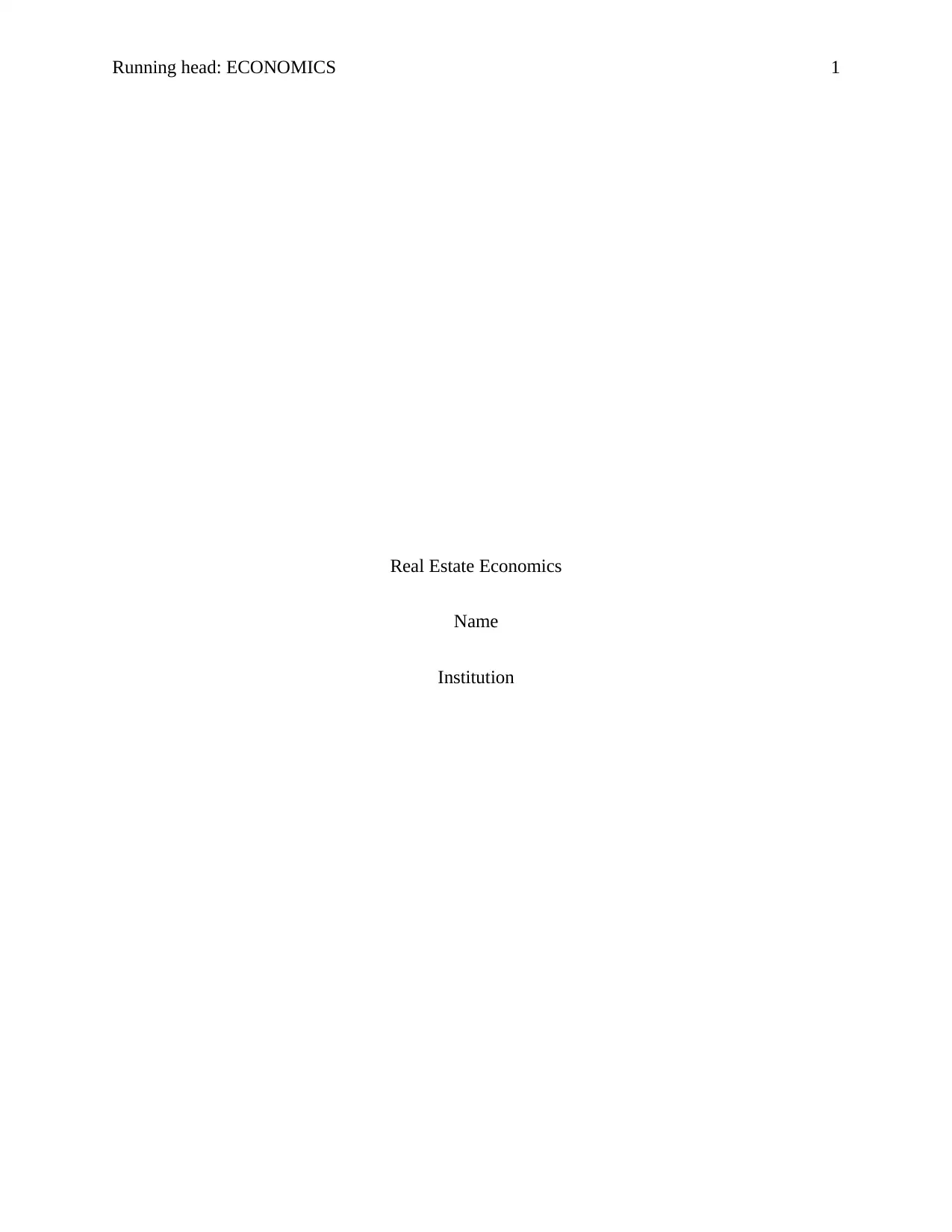
Running head: ECONOMICS 1
Real Estate Economics
Name
Institution
Real Estate Economics
Name
Institution
Paraphrase This Document
Need a fresh take? Get an instant paraphrase of this document with our AI Paraphraser
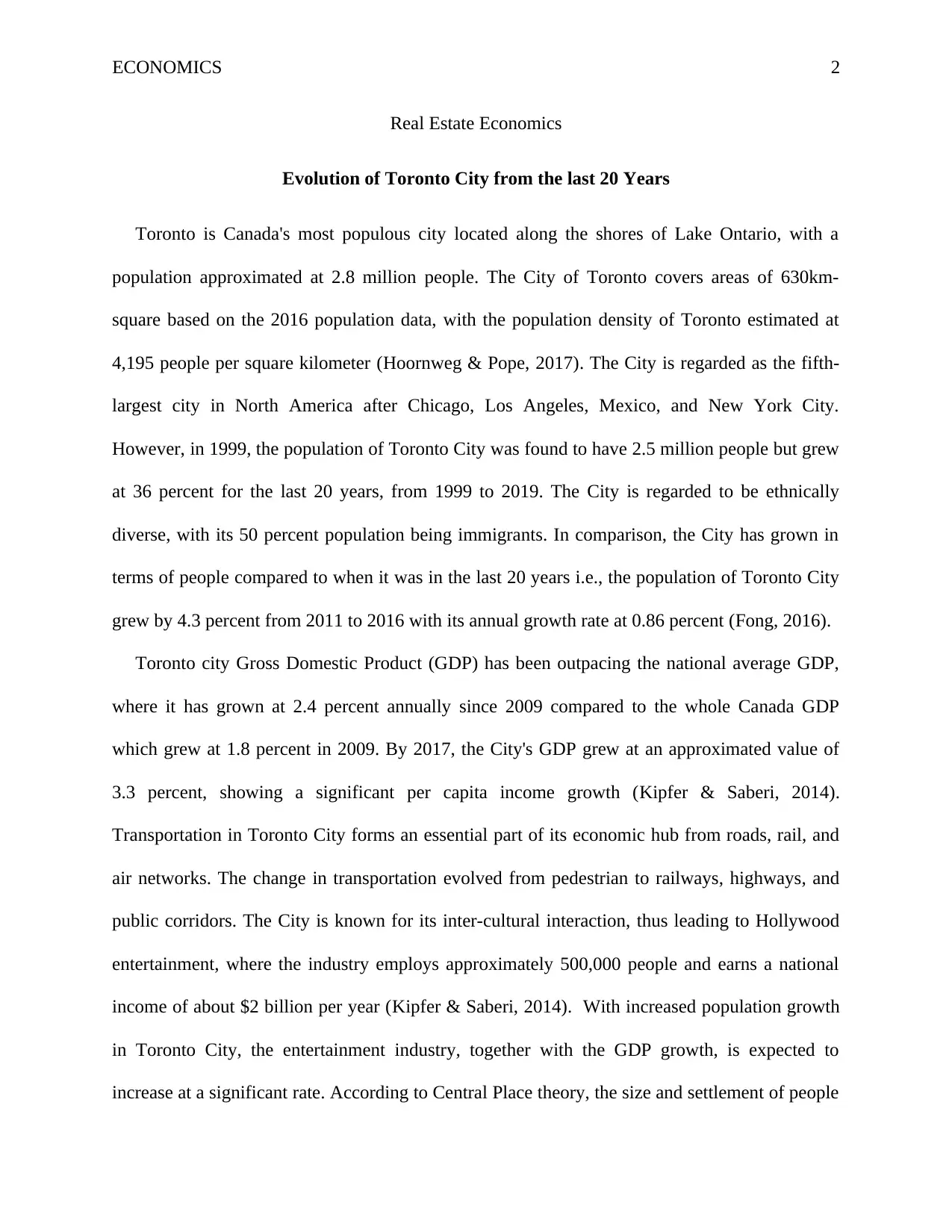
ECONOMICS 2
Real Estate Economics
Evolution of Toronto City from the last 20 Years
Toronto is Canada's most populous city located along the shores of Lake Ontario, with a
population approximated at 2.8 million people. The City of Toronto covers areas of 630km-
square based on the 2016 population data, with the population density of Toronto estimated at
4,195 people per square kilometer (Hoornweg & Pope, 2017). The City is regarded as the fifth-
largest city in North America after Chicago, Los Angeles, Mexico, and New York City.
However, in 1999, the population of Toronto City was found to have 2.5 million people but grew
at 36 percent for the last 20 years, from 1999 to 2019. The City is regarded to be ethnically
diverse, with its 50 percent population being immigrants. In comparison, the City has grown in
terms of people compared to when it was in the last 20 years i.e., the population of Toronto City
grew by 4.3 percent from 2011 to 2016 with its annual growth rate at 0.86 percent (Fong, 2016).
Toronto city Gross Domestic Product (GDP) has been outpacing the national average GDP,
where it has grown at 2.4 percent annually since 2009 compared to the whole Canada GDP
which grew at 1.8 percent in 2009. By 2017, the City's GDP grew at an approximated value of
3.3 percent, showing a significant per capita income growth (Kipfer & Saberi, 2014).
Transportation in Toronto City forms an essential part of its economic hub from roads, rail, and
air networks. The change in transportation evolved from pedestrian to railways, highways, and
public corridors. The City is known for its inter-cultural interaction, thus leading to Hollywood
entertainment, where the industry employs approximately 500,000 people and earns a national
income of about $2 billion per year (Kipfer & Saberi, 2014). With increased population growth
in Toronto City, the entertainment industry, together with the GDP growth, is expected to
increase at a significant rate. According to Central Place theory, the size and settlement of people
Real Estate Economics
Evolution of Toronto City from the last 20 Years
Toronto is Canada's most populous city located along the shores of Lake Ontario, with a
population approximated at 2.8 million people. The City of Toronto covers areas of 630km-
square based on the 2016 population data, with the population density of Toronto estimated at
4,195 people per square kilometer (Hoornweg & Pope, 2017). The City is regarded as the fifth-
largest city in North America after Chicago, Los Angeles, Mexico, and New York City.
However, in 1999, the population of Toronto City was found to have 2.5 million people but grew
at 36 percent for the last 20 years, from 1999 to 2019. The City is regarded to be ethnically
diverse, with its 50 percent population being immigrants. In comparison, the City has grown in
terms of people compared to when it was in the last 20 years i.e., the population of Toronto City
grew by 4.3 percent from 2011 to 2016 with its annual growth rate at 0.86 percent (Fong, 2016).
Toronto city Gross Domestic Product (GDP) has been outpacing the national average GDP,
where it has grown at 2.4 percent annually since 2009 compared to the whole Canada GDP
which grew at 1.8 percent in 2009. By 2017, the City's GDP grew at an approximated value of
3.3 percent, showing a significant per capita income growth (Kipfer & Saberi, 2014).
Transportation in Toronto City forms an essential part of its economic hub from roads, rail, and
air networks. The change in transportation evolved from pedestrian to railways, highways, and
public corridors. The City is known for its inter-cultural interaction, thus leading to Hollywood
entertainment, where the industry employs approximately 500,000 people and earns a national
income of about $2 billion per year (Kipfer & Saberi, 2014). With increased population growth
in Toronto City, the entertainment industry, together with the GDP growth, is expected to
increase at a significant rate. According to Central Place theory, the size and settlement of people
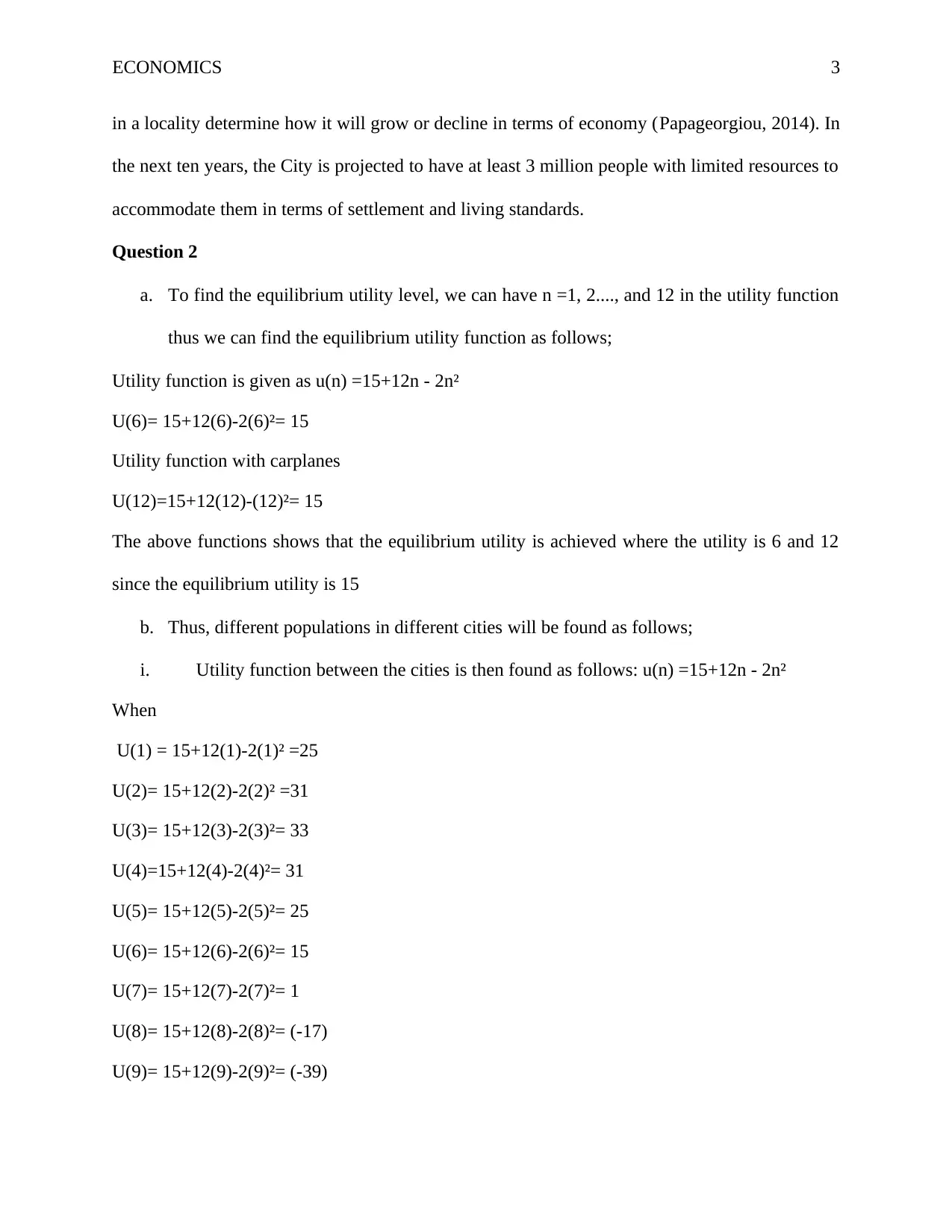
ECONOMICS 3
in a locality determine how it will grow or decline in terms of economy (Papageorgiou, 2014). In
the next ten years, the City is projected to have at least 3 million people with limited resources to
accommodate them in terms of settlement and living standards.
Question 2
a. To find the equilibrium utility level, we can have n =1, 2...., and 12 in the utility function
thus we can find the equilibrium utility function as follows;
Utility function is given as u(n) =15+12n - 2n²
U(6)= 15+12(6)-2(6)²= 15
Utility function with carplanes
U(12)=15+12(12)-(12)²= 15
The above functions shows that the equilibrium utility is achieved where the utility is 6 and 12
since the equilibrium utility is 15
b. Thus, different populations in different cities will be found as follows;
i. Utility function between the cities is then found as follows: u(n) =15+12n - 2n²
When
U(1) = 15+12(1)-2(1)² =25
U(2)= 15+12(2)-2(2)² =31
U(3)= 15+12(3)-2(3)²= 33
U(4)=15+12(4)-2(4)²= 31
U(5)= 15+12(5)-2(5)²= 25
U(6)= 15+12(6)-2(6)²= 15
U(7)= 15+12(7)-2(7)²= 1
U(8)= 15+12(8)-2(8)²= (-17)
U(9)= 15+12(9)-2(9)²= (-39)
in a locality determine how it will grow or decline in terms of economy (Papageorgiou, 2014). In
the next ten years, the City is projected to have at least 3 million people with limited resources to
accommodate them in terms of settlement and living standards.
Question 2
a. To find the equilibrium utility level, we can have n =1, 2...., and 12 in the utility function
thus we can find the equilibrium utility function as follows;
Utility function is given as u(n) =15+12n - 2n²
U(6)= 15+12(6)-2(6)²= 15
Utility function with carplanes
U(12)=15+12(12)-(12)²= 15
The above functions shows that the equilibrium utility is achieved where the utility is 6 and 12
since the equilibrium utility is 15
b. Thus, different populations in different cities will be found as follows;
i. Utility function between the cities is then found as follows: u(n) =15+12n - 2n²
When
U(1) = 15+12(1)-2(1)² =25
U(2)= 15+12(2)-2(2)² =31
U(3)= 15+12(3)-2(3)²= 33
U(4)=15+12(4)-2(4)²= 31
U(5)= 15+12(5)-2(5)²= 25
U(6)= 15+12(6)-2(6)²= 15
U(7)= 15+12(7)-2(7)²= 1
U(8)= 15+12(8)-2(8)²= (-17)
U(9)= 15+12(9)-2(9)²= (-39)
⊘ This is a preview!⊘
Do you want full access?
Subscribe today to unlock all pages.

Trusted by 1+ million students worldwide
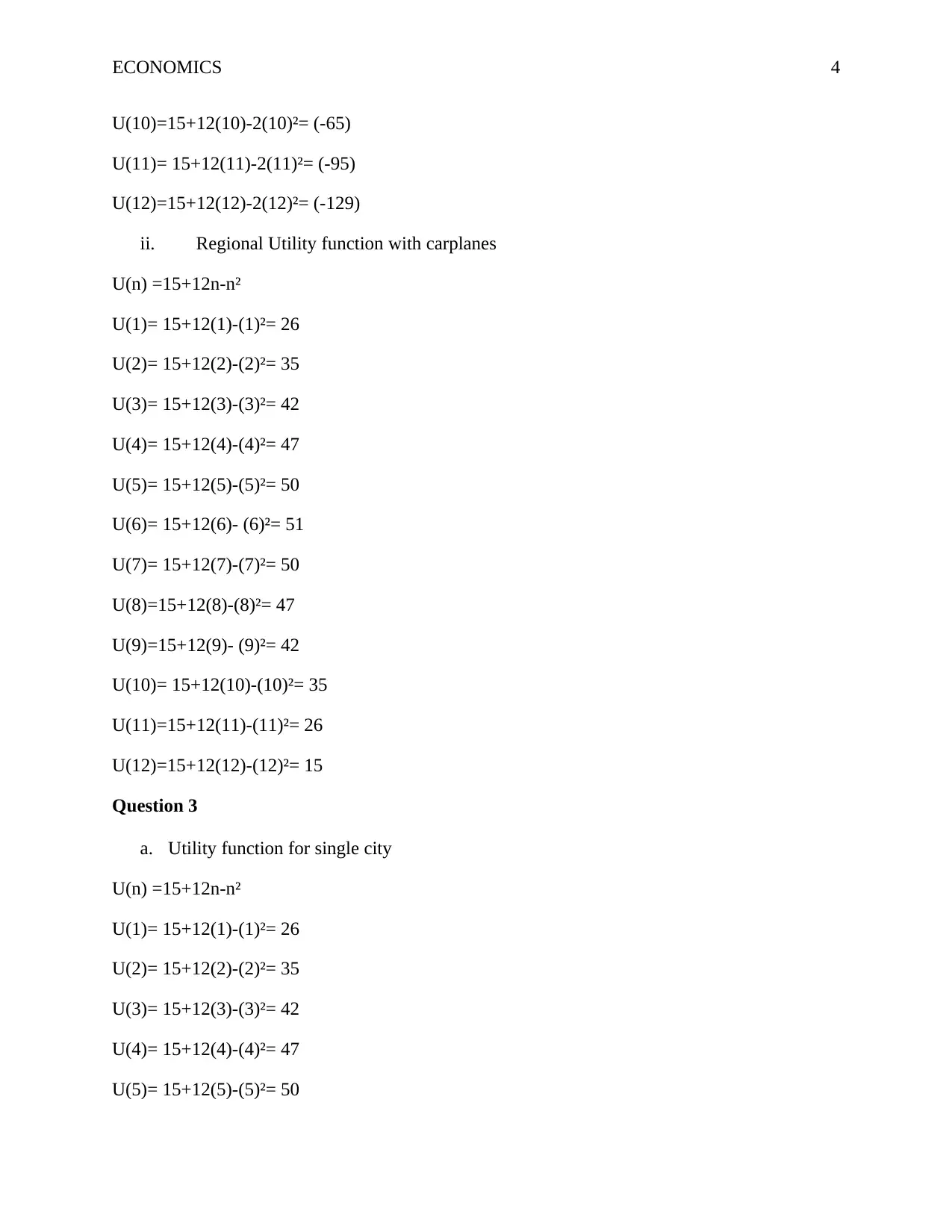
ECONOMICS 4
U(10)=15+12(10)-2(10)²= (-65)
U(11)= 15+12(11)-2(11)²= (-95)
U(12)=15+12(12)-2(12)²= (-129)
ii. Regional Utility function with carplanes
U(n) =15+12n-n²
U(1)= 15+12(1)-(1)²= 26
U(2)= 15+12(2)-(2)²= 35
U(3)= 15+12(3)-(3)²= 42
U(4)= 15+12(4)-(4)²= 47
U(5)= 15+12(5)-(5)²= 50
U(6)= 15+12(6)- (6)²= 51
U(7)= 15+12(7)-(7)²= 50
U(8)=15+12(8)-(8)²= 47
U(9)=15+12(9)- (9)²= 42
U(10)= 15+12(10)-(10)²= 35
U(11)=15+12(11)-(11)²= 26
U(12)=15+12(12)-(12)²= 15
Question 3
a. Utility function for single city
U(n) =15+12n-n²
U(1)= 15+12(1)-(1)²= 26
U(2)= 15+12(2)-(2)²= 35
U(3)= 15+12(3)-(3)²= 42
U(4)= 15+12(4)-(4)²= 47
U(5)= 15+12(5)-(5)²= 50
U(10)=15+12(10)-2(10)²= (-65)
U(11)= 15+12(11)-2(11)²= (-95)
U(12)=15+12(12)-2(12)²= (-129)
ii. Regional Utility function with carplanes
U(n) =15+12n-n²
U(1)= 15+12(1)-(1)²= 26
U(2)= 15+12(2)-(2)²= 35
U(3)= 15+12(3)-(3)²= 42
U(4)= 15+12(4)-(4)²= 47
U(5)= 15+12(5)-(5)²= 50
U(6)= 15+12(6)- (6)²= 51
U(7)= 15+12(7)-(7)²= 50
U(8)=15+12(8)-(8)²= 47
U(9)=15+12(9)- (9)²= 42
U(10)= 15+12(10)-(10)²= 35
U(11)=15+12(11)-(11)²= 26
U(12)=15+12(12)-(12)²= 15
Question 3
a. Utility function for single city
U(n) =15+12n-n²
U(1)= 15+12(1)-(1)²= 26
U(2)= 15+12(2)-(2)²= 35
U(3)= 15+12(3)-(3)²= 42
U(4)= 15+12(4)-(4)²= 47
U(5)= 15+12(5)-(5)²= 50
Paraphrase This Document
Need a fresh take? Get an instant paraphrase of this document with our AI Paraphraser

ECONOMICS 5
U(6)= 15+12(6)- (6)²= 51
U(7)= 15+12(7)-(7)²= 50
U(8)=15+12(8)-(8)²= 47
U(9)=15+12(9)- (9)²= 42
U(10)= 15+12(10)-(10)²= 35
U(11)=15+12(11)-(11)²= 26
New equilibrium utility will be at 26
b. Subsidy function is given at s = 12 – 2n
U(1)= 15+12(1)-(1)²= 26 and subsidy function is s (10) = 12 – 2(1) = 10
26-10 = 16
U(2)= 15+12(2)-(2)²= 35 and subsidy function is s (8) = 12 – 2(2) = 8
35 -8 = 27
U(3)= 15+12(3)-(3)²= 42 , s (6) = 12 – 2(3) = 6
42-6 =36
U(4)= 15+12(4)-(4)²= 47, s (4) = 12 – 2(4) = 4
47-4 =43
U(5)= 15+12(5)-(5)²= 50, s (2) = 12 – 2(5) = 2
50 – 2 =48
U(6)= 15+12(6)- (6)²= 51, s (0) = 12 – 2(10) = 0
51 – 0 =51
U(7)= 15+12(7)-(7)²= 50
U(8)=15+12(8)-(8)²= 47
U(9)=15+12(9)- (9)²= 42
U(10)= 15+12(10)-(10)²= 35
U(6)= 15+12(6)- (6)²= 51
U(7)= 15+12(7)-(7)²= 50
U(8)=15+12(8)-(8)²= 47
U(9)=15+12(9)- (9)²= 42
U(10)= 15+12(10)-(10)²= 35
U(11)=15+12(11)-(11)²= 26
New equilibrium utility will be at 26
b. Subsidy function is given at s = 12 – 2n
U(1)= 15+12(1)-(1)²= 26 and subsidy function is s (10) = 12 – 2(1) = 10
26-10 = 16
U(2)= 15+12(2)-(2)²= 35 and subsidy function is s (8) = 12 – 2(2) = 8
35 -8 = 27
U(3)= 15+12(3)-(3)²= 42 , s (6) = 12 – 2(3) = 6
42-6 =36
U(4)= 15+12(4)-(4)²= 47, s (4) = 12 – 2(4) = 4
47-4 =43
U(5)= 15+12(5)-(5)²= 50, s (2) = 12 – 2(5) = 2
50 – 2 =48
U(6)= 15+12(6)- (6)²= 51, s (0) = 12 – 2(10) = 0
51 – 0 =51
U(7)= 15+12(7)-(7)²= 50
U(8)=15+12(8)-(8)²= 47
U(9)=15+12(9)- (9)²= 42
U(10)= 15+12(10)-(10)²= 35

ECONOMICS 6
U(11)=15+12(11)-(11)²= 26
New equilibrium distribution will be at a point where n =6 thus giving the value of equilibrium
utility to be equal to 51.
U(11)=15+12(11)-(11)²= 26
New equilibrium distribution will be at a point where n =6 thus giving the value of equilibrium
utility to be equal to 51.
⊘ This is a preview!⊘
Do you want full access?
Subscribe today to unlock all pages.

Trusted by 1+ million students worldwide
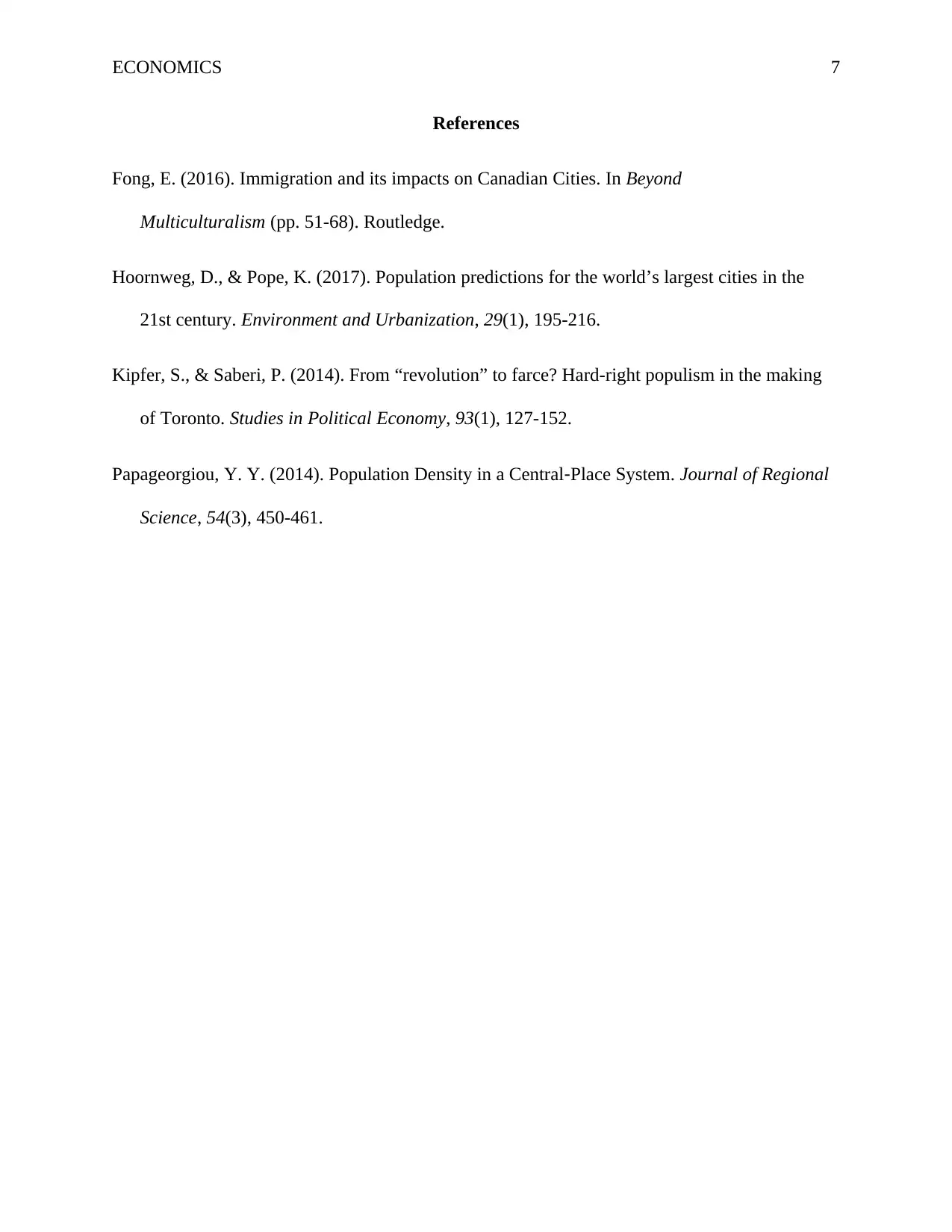
ECONOMICS 7
References
Fong, E. (2016). Immigration and its impacts on Canadian Cities. In Beyond
Multiculturalism (pp. 51-68). Routledge.
Hoornweg, D., & Pope, K. (2017). Population predictions for the world’s largest cities in the
21st century. Environment and Urbanization, 29(1), 195-216.
Kipfer, S., & Saberi, P. (2014). From “revolution” to farce? Hard-right populism in the making
of Toronto. Studies in Political Economy, 93(1), 127-152.
Papageorgiou, Y. Y. (2014). Population Density in a Central‐Place System. Journal of Regional
Science, 54(3), 450-461.
References
Fong, E. (2016). Immigration and its impacts on Canadian Cities. In Beyond
Multiculturalism (pp. 51-68). Routledge.
Hoornweg, D., & Pope, K. (2017). Population predictions for the world’s largest cities in the
21st century. Environment and Urbanization, 29(1), 195-216.
Kipfer, S., & Saberi, P. (2014). From “revolution” to farce? Hard-right populism in the making
of Toronto. Studies in Political Economy, 93(1), 127-152.
Papageorgiou, Y. Y. (2014). Population Density in a Central‐Place System. Journal of Regional
Science, 54(3), 450-461.
1 out of 7
Your All-in-One AI-Powered Toolkit for Academic Success.
+13062052269
info@desklib.com
Available 24*7 on WhatsApp / Email
![[object Object]](/_next/static/media/star-bottom.7253800d.svg)
Unlock your academic potential
Copyright © 2020–2025 A2Z Services. All Rights Reserved. Developed and managed by ZUCOL.